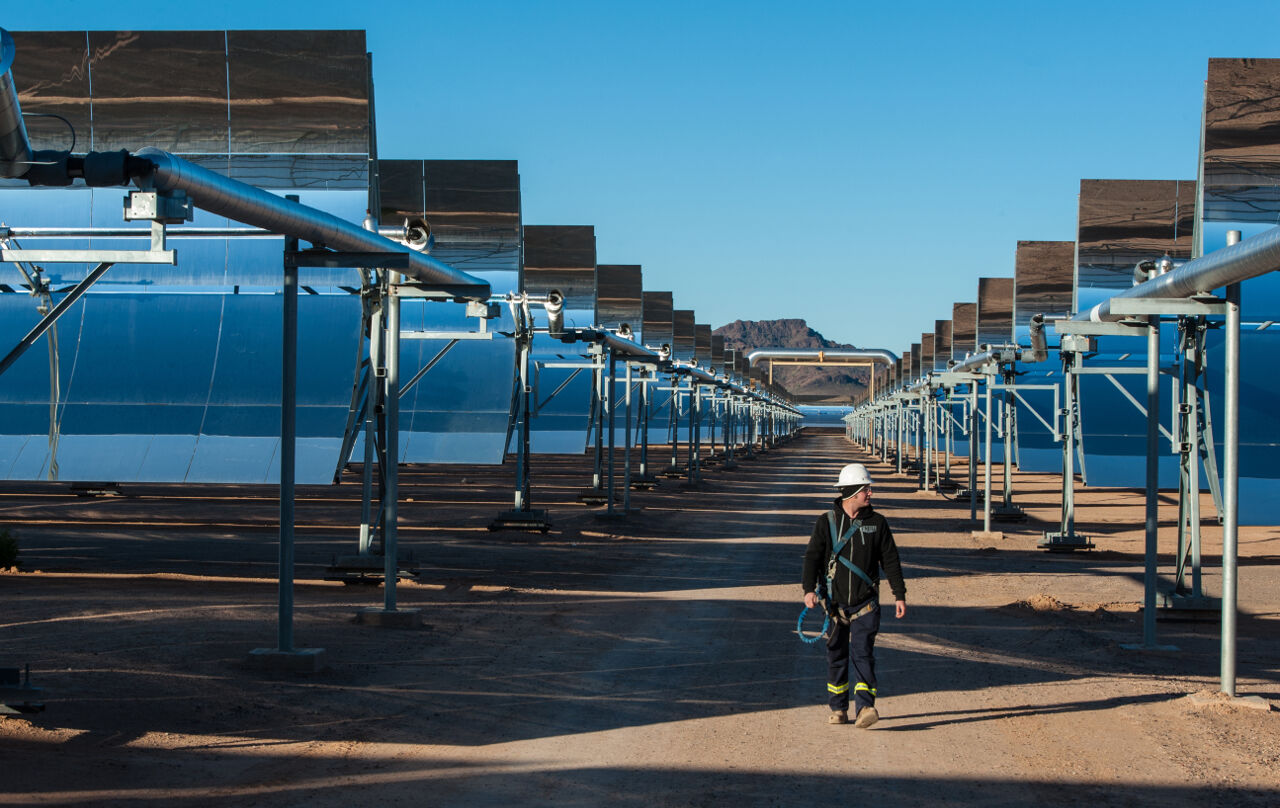While searching the Internet, this photo (above) came to my eye, and I said, WOW, man! It’s an incredible solution! Who made it? WOW! I wanted… No; I needed to know more, so I searched for – Abengoa. There was good and bad news that I found. But what fascinated me was – this green power company is driven by its people. Well, you’ll see if I caught your attention, but first, see this:
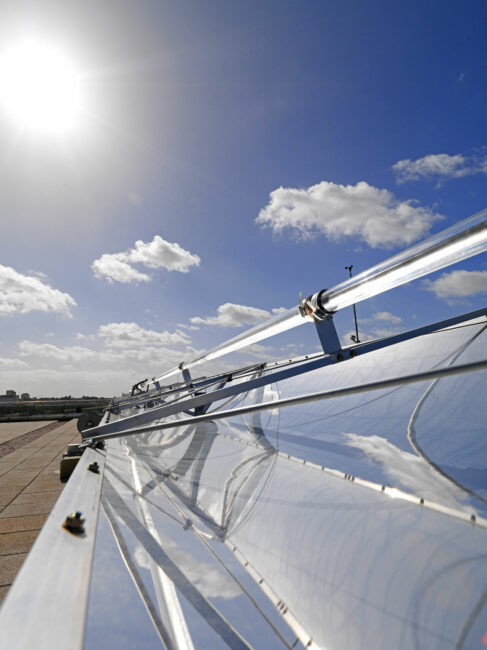
What’s Abengoa doing?
Their corporate website is fabulous. It gives you all you need to know, so we may call it a dream of every journalist. But – enormous question mark here – it is not up to date. And I wondered why. But the first thing first.
Abengoa SA activities are in four main areas: energy, water, transmission and infrastructures, and services. It specialized in two high-growth sectors – energy and environment – which are my field of interest. (I cannot prevent myself from watching those photographs. Sorry if I sound biased, I swear to the sun, wind, and water – I’m not.) They, Abengoa, say they are international leaders in these fields.
Abengoa SA is a Spanish business that offers technology solutions to the engineering industry. There are three primary business divisions within the Company. The turnkey power plant projects, hydraulic infrastructure, and electric transmission lines are all completed by the Industrial Engineering and Construction division. Operating power plants for desalination and production, such as solar, wind, and cogeneration, is a part of the concession-type infrastructure segment. (Look at those photographs! Sorry.)
The development of solar thermal technology, the manufacturing of biofuels, and waste treatment are all included in industrial production. The Company owned a number of subsidiaries as of December 31, 2011, including Abengoa Bioenergia SA, Abengoa Solar SA, Simosa IT SA, and Siema Technologies SL. With a 49.9% shareholding in the company, Inversion Corporativa IC SA was also a significant shareholder.
But why the Abengoa website is not up to date?
Abengoa SA is a bit in trouble and the Spanish government won’t help. Thus, the following decision was made by the Comisión Nacional del Mercado de Valores on September 22, 2022: “To remove from trading the shares of ABENGOA, S.A. (in liquidation) from the Stock Exchanges of Madrid and Barcelona as well as from the Sistema de Interconexión Bursátil, in accordance with Article 21.2 of the Royal DecreeLaw 21/2017 of December on urgent measures for the adaptation of Spanish law to European Union regulations on the securities Class A and Class B shares of Abengoa, S.A., as well as other securities that grant rights to their holders, are affected by this agreement.”
Why Spain’s Abengoa asked to start insolvency proceedings for the main unit in June 2022?
The insolvency proceedings started following the rejection by the Spanish government, of the company’s request for 249 million euros ($261.2 million) in state aid. It was supposed to aid the Abenewco 1 unit and would have given Abengoa more time to consider a takeover bid from U.S. private equity firm TerraMar Capital.
True, for more than ten years, the Seville-based company had taken on a lot of debt to finance its fast development into clean energy projects from its usual infrastructure projects. Notice THIS: “fast development into clean energy projects”. Call me biased, but what’s wrong with this? Why did the creditors refuse to extend the deadline for negotiating a restructuring arrangement?
The bulk of the 13,500 employees of the group works for Abenewco 1, which controls the majority of the parent company’s assets and liabilities. Abenewco 1 was not involved in those insolvency procedures. But, also I saw this:
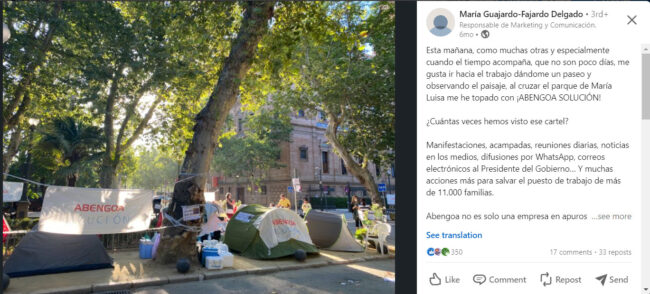
…and it broke my heart.
Still, good news for Abengoa to continue
After these unfortunate events, this fall Abengoa got several prestigious awards. One of the most prestigious was the award for the Solar project of the Year of Renewable Energy 2022. The Abengoa engineer got it at the 3rd Solar+Hydrogen Madrid Conference in September this year due to the glittering Abengoa’s accomplishments on energy transitions and hard work for decarbonized society.
That’s what happens when human power powers green energy and fast energy transition. Abengoa continues to ride the wind, capture the sun, and fuel the industry – and your car – with green options. They continue to do what they do – making energy and saving the environment.
How did Abengoa do that – making green energy and saving the environment?
Abengoa understood that it is crucial to develop new energy-related solutions. They had in mind solutions that rely on sustainable and renewable resources. Abengoa gave them priority, in light of the rising need for energy on a global scale, even though is much easier to do that “in the old ways” with gas and oil.
Abengoa kept building facilities that transform renewable energy sources into electricity and biofuels. They build transmission lines that support electric grids and develop and deploy information systems to intelligently and safely manage crucial infrastructure.
With open cycle and mixed cycle technologies, cogeneration, wind farms, solar thermal, photovoltaic, and biomass facilities, which together have a combined installed and under construction capacity of more than 13 GW, Abengoa has extensive experience in the energy generation sector.
In all of these fields, including development, engineering, purchasing, construction, plant commissioning, as well as delivering operation and maintenance, Abengoa is doing turnkey (and EPCM) projects.
We should highlight that their strong design capabilities and technology hybridization allow them to provide the finest solution to the clients.
And that is why Abengoa deserves support.
Abengoa’s wizards of innovations
Did I mention they got awards for their innovations? Well, it was a long path to prestigious awards. And a lot of work of devoted people, not only to the company but to the cause of energy transition too.
One of the good ways is using solar energy. Solar thermal energy harnesses the heat from the sun generating plenty of clean electricity afterward used immediately. But also it is a storage-capable renewable technology. It can deliver power to the grid when it is needed. Even during times when there isn’t much sunlight.
Abengoa is still a global leader in solar thermal technology, having invented, constructed, built, and/or operated solar thermal plants on four continents with a combined capacity of 1.9 GW, or almost 30% of the capacity in the world. Additionally, the business is currently involved in 52% of the solar thermal capacity in the process of building. Its offerings in this area include component development (solar field), engineering services, EPC, consulting, technological assistance, and O&M services.
Solar technologies
Abengoa creates the two most popular commercial solar thermal technologies. The first is the so-called “tower”. This device enables the generation of electricity by focusing solar energy, which is captured by a field of heliostats, onto a receiver point situated on the higher section of a tower. Abengoa was a pioneer in building such tower plants for commercial use.
The second is a “parabolic trough”. Using a parabolic trough collector, it is possible to heat a heat transfer fluid for use in a typical thermal cycle. This method is based on the capture of solar energy. Abengoa is a pioneer in the construction of these types of facilities too.
Besides, Abengoa creates, constructs, and manages solar power facilities on the ground (with or without solar tracking) or on roofs, where they install photovoltaic panels. This sounds more familiar, isn’t it?
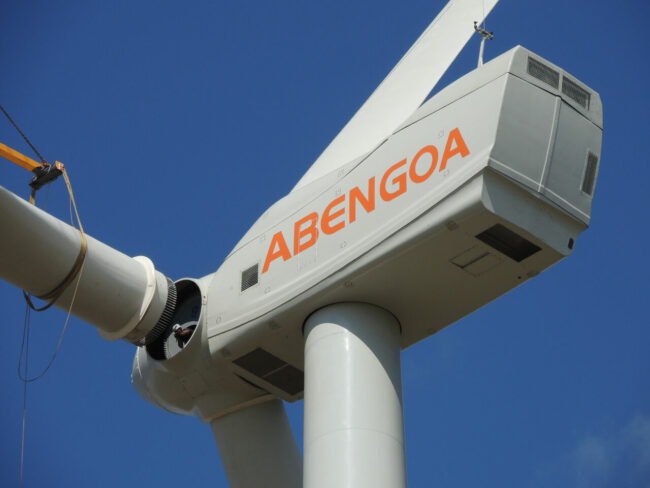
The sun, then the wind…
Given that it comes from a non-depletable source and emits no harmful pollutants or emissions while being produced, the wind is one of the safest and cleanest ways to produce renewable energy available today.
Since 1985, Abengoa has been actively involved in projects relating to the wind energy industry for more than 33 years, gaining experience with more than 480 MW globally. They are involved in the whole process – resource analysis, turbine optimization, engineering, logistical planning, construction, and operation of the wind farm.
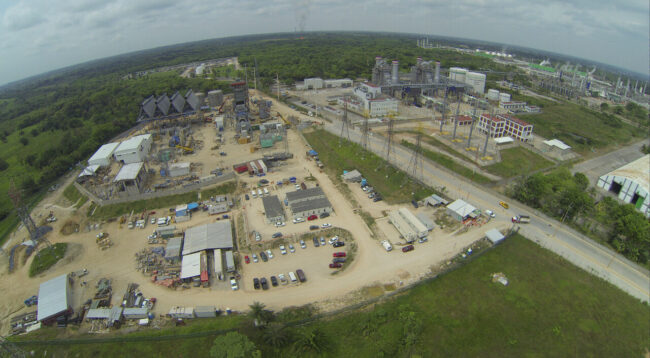
Why waste the waste?
Well, no one likes waste… except Abengoa. Together with biomass, they make energy from waste.
Eliminating waste produced by human activity and cutting back on the use of fossil fuels are two main ways to safeguard the environment in the context of sustainability and durability. It helps to mitigate the greenhouse effect. The energy recovery of biomass and trash is one remedy.
The design and integration of intelligent solutions, the construction and operation of cutting-edge facilities for the energy recovery of all waste and biomass, and the acquisition of renewable and sustainable energy in the form of heat, cold, electricity, or fuel are specialties at Abengoa.
According to the type of waste and/or biomass – urban garbage, wood, livestock, agrifood, and industrial waste, for example – Abengoa builds creative ways to transform the raw material and use it as bioenergy. Bioenergy then finds its use as electricity, heat, or cooling for city grids or industrial operations through incineration, gasification, etc. Also, Abengoa makes biofuel – bioethanol, biodiesel, jet fuel, and biogas – from waste. Why waste the waste?
People make the company
Abengoa says that their core values are their work to be an example of moral principles that will guide how partners, suppliers, and collaborators behave. The only way to increase consumer confidence and public respect is by adhering to ethical standards, Abengoa says.
As we saw from the above, they do that well too.

